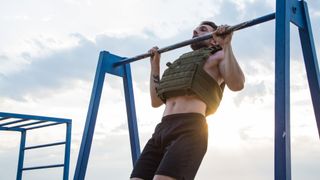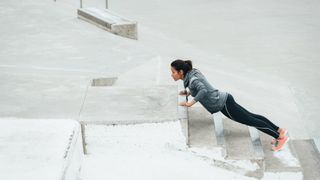What is the Murph workout, and how can you modify it?
Here’s what you need to know about the Memorial Day challenge

The Murph workout is a CrossFit WOD — that’s workout of the day for those not familiar with the lingo — that takes place each Memorial Day. It’s one of the most brutal and most notorious CrossFit workouts out there. But how can you try it, and more importantly, how can you modify it if you want to give it a go on Monday, May 31?
Let’s start by taking a look at the Murph workout and the meaning behind it. The Murph workout is one of CrossFit’s "hero WODS," named after Navy Lieutenant Michael Murphy, who was killed in Afghanistan in 2005. The workout, used by the Navy Seals, was said to be one of Murphy’s favorite workouts, so each Memorial Day, CrossFitters all over the globe attempt to complete the “Murph Challenge” in Murphy’s honor.
It goes without saying, if you’re a complete beginner, this workout is not a good place to start. What works for one person might not work for another, and if you’re new to an exercise, it’s a good idea to get a personal trainer to ensure you’re getting your form right before adding weight to your reps.
Looking for more workout inspiration? Here’s what happened when I tried Chris Hesmworth’s 800 rep workout, when I did 100 dead bugs a day for a week, and when I added a plank to my morning routine.
What is the Murph workout?
The Murph workout goes as follows:
- 1-mile run
- 100 pull-ups
- 200 push-ups
- 300 air squats (bodyweight squats)
- 1-mile run
The entire workout is done wearing a 20lb weighted vest, to stimulate the body armor Murphey would have worn. For CrossFit competitions, men wear a 20lb vest and women a 14lb vest, although of course, this isn’t a requirement and the workout is hard enough without the extra weight.
How can you modify the Murph workout?
If you fancy trying the Murph workout but aren’t quite up to the challenge, there’s a few different options to choose from. Firstly, you could ditch the weighted vest — the workout is tough enough without it, and if your form isn’t correct, adding the weight can put extra pressure on your lower back.
Sign up to get the BEST of Tom’s Guide direct to your inbox.
Upgrade your life with a daily dose of the biggest tech news, lifestyle hacks and our curated analysis. Be the first to know about cutting-edge gadgets and the hottest deals.
Secondly, you could split the reps up so they don’t seem as daunting, and add breaks between exercises. For example — do 10 sets of 10 pull-ups, rather than trying to shoot for 100 in one go.
Finally, halve the number of reps in the challenge, and try some of the modifications below.
How to modify a pull-up

To make a pull-up easier, use an assisted pull-up machine in the gym to help you work on the muscles needed for a full pull-up, or use a resistance band. (We’ve hand-picked the best resistance bands on the market here.)
To use a resistance band, throw a long band over the pull up bar and pull one end through the other, so the band is looped around the bar. Put one foot through the loop, and hang from the bar. Keeping your foot in the resistance band, bend your arms to pull your torso upward, until your chin raises just above the bar.
If these alternatives are still too difficult, switch the exercise out for lateral pulldowns, which works similar muscles to a pull-up.
How to modify a push-up

If you’re looking to make push-ups easier, you have a few different options. First, do the exercise with your knees on the ground — be sure to keep your core engaged for the entire exercise, and lower your torso slowly to the ground before pressing back up again. If this is still too difficult, try doing a push-up on an elevated surface, such as a box or bench.
Finally, you can also use resistance bands to help make the exercise easier, here’s how to do a push-up using a resistance band.
Here’s more information on how to do a push-up with the correct form.
How to modify an air squat

When focusing on the Murph challenge, the most obvious way to make the squat section easier is to reduce the reps — 300 is a lot of squats. That said, if you’re struggling to do a bodyweight squat, you probably need to take a look at your form.
To do a bodyweight squat with the correct form, start with your feet slightly wider than hip-width apart, with your toes slightly pointing outward. Keeping your torso upright, engage your core and shift your hips back and down, bending at the knees to lower your glutes down to the ground. Aim to get your thighs parallel to the floor, before raising back to your starting position.
If you find you’re getting lower back pain from bodyweight squats, the chances are you’re not engaging your core during the exercise — think about sucking your belly button into your spine. If you get knee pain, the chances are you’re letting your knees collapse inwards during the exercise, putting more pressure on the joint — think about pushing your knees out to the side as you press down. If you struggle to do this, pop a resistance band around your thighs.

Jane McGuire is Tom's Guide's Fitness editor, which means she looks after everything fitness related - from running gear to yoga mats. An avid runner, Jane has tested and reviewed fitness products for the past five years, so knows what to look for when finding a good running watch or a pair of shorts with pockets big enough for your smartphone. When she's not pounding the pavements, you'll find Jane striding round the Surrey Hills, taking far too many photos of her puppy.
